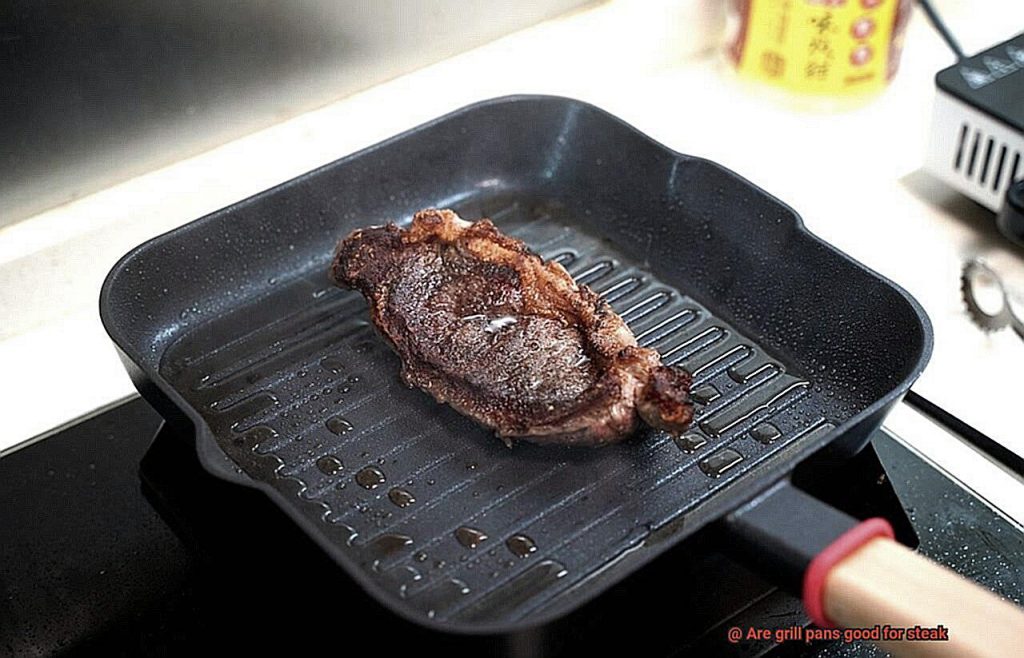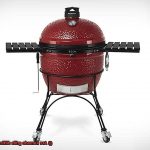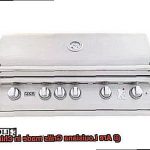Calling all steak enthusiasts. Cooking the perfect steak is an art, and it requires both skill and the right equipment. There are many ways to cook a steak, but have you ever considered using a trusty grill pan? The question is: are grill pans really good for cooking steak? Can they create that irresistible charred crust and juicy interior that we all crave?
In this blog post, we’ll delve into the pros and cons of using a grill pan for cooking steak. We’ll also share some expert tips on how to get the best results when using a grill pan, and perhaps even reveal some secret tricks from the pros.
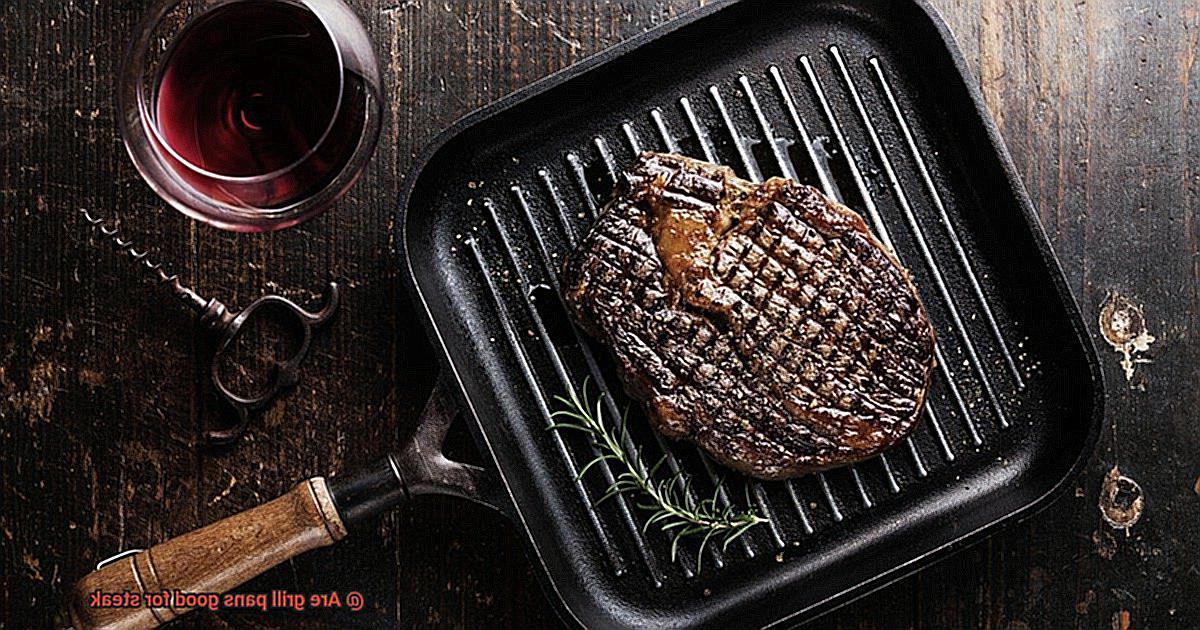
Some people swear by grill pans for their ability to create those iconic grill marks, while others stick to the traditional outdoor grill. But what sets these two methods apart? Is one superior to the other? Fear not, as we’ll answer all your burning questions (pun intended).
Whether you’re a seasoned grill master or just starting out in the world of steaks, this post is tailored for you. So don your apron, fire up your stove, and let’s get sizzling.
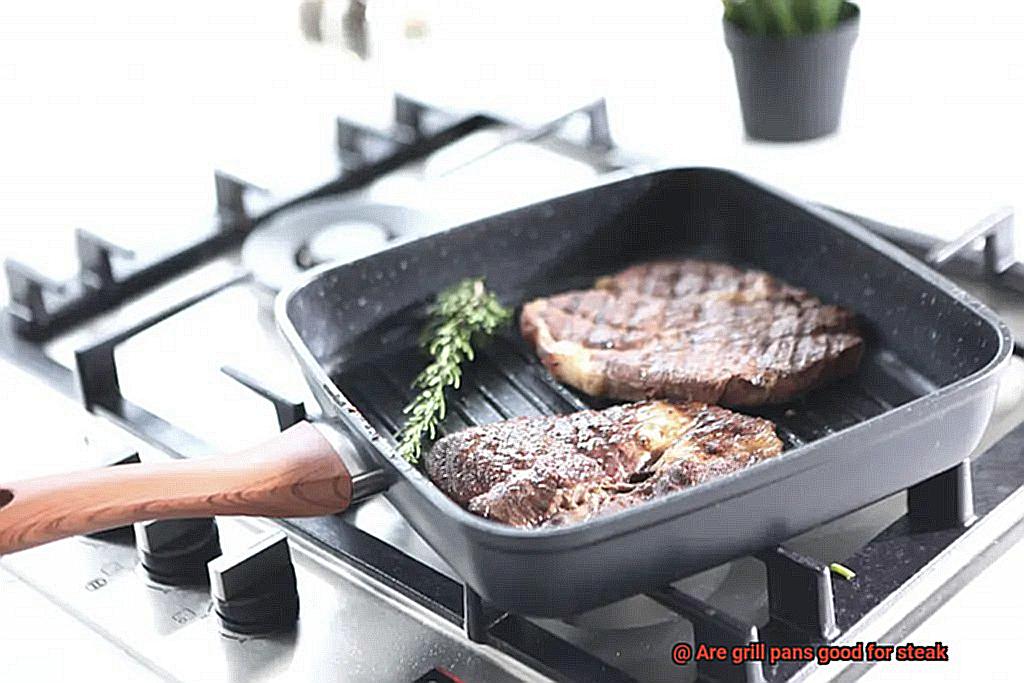
Contents
What is a Grill Pan?
For those who love the taste of grilled food but lack access to an outdoor grill, a grill pan is the perfect solution. A grill pan is a kitchen utensil that mimics the grilling effect of an outdoor grill by using raised ridges or grooves on its surface. These ridges create those coveted char marks on your food, giving it a smoky flavor and visually appealing appearance.
Grill pans are typically made of cast iron, which is an excellent heat conductor and distributes heat evenly across the surface of the pan. It also retains heat well, making it perfect for cooking steak at high temperatures for a short period of time.
The best grill pans have deep ridges made of heavy cast iron or stainless steel. This allows excess fat to drip away from your meat, resulting in a healthier finished product. Additionally, thicker cuts of steak (1 inch or more) are better suited for a grill pan as they require longer cooking times, which gives them time to develop a nice crust on the outside while remaining juicy and tender on the inside.
The key to success when using a grill pan is to preheat it over medium-high heat for at least 5 minutes before adding your steak. This ensures that you hear that satisfying sizzle when the steak hits the pan – if you don’t, it’s not hot enough. Once you’ve achieved that perfect sear, let your steak rest for a few minutes after cooking to allow the juices to redistribute throughout the meat.
Grill pans come in different shapes and sizes, but the most common shape is square or rectangular. This shape allows for more surface area, allowing you to cook multiple pieces of meat or vegetables at once. Some grill pans even come with a detachable handle, making it easier to transfer the pan from stovetop to oven for finishing off thicker cuts of meat.
Benefits of Using a Grill Pan for Steak
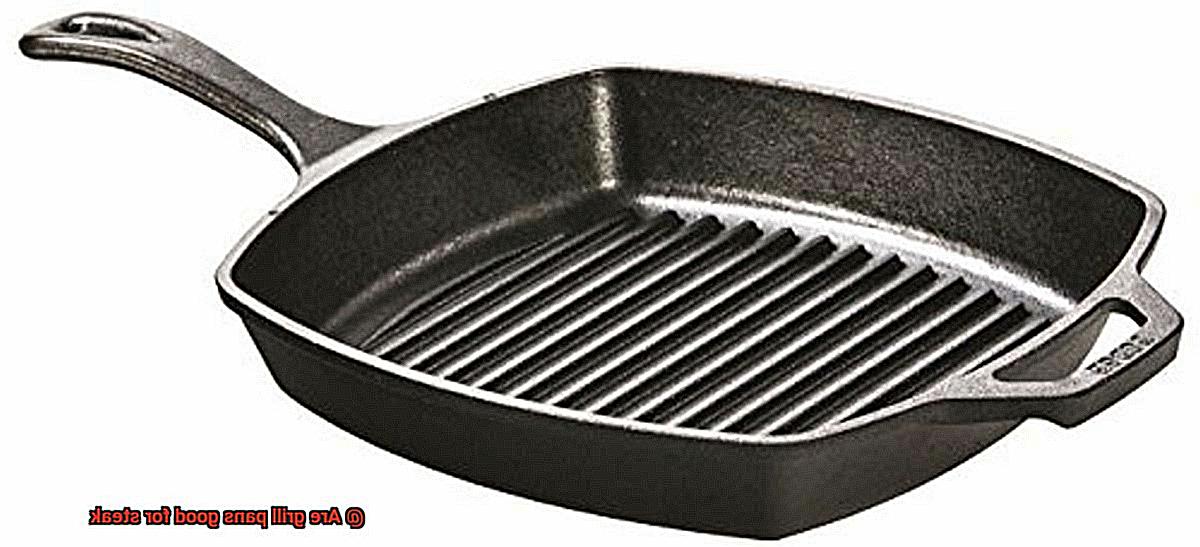
Look no further than your kitchen for a game-changing tool: the grill pan. As an expert on the benefits of using a grill pan for steak, I can assure you that this kitchen gadget is a steak lover’s dream.
Firstly, grill pans allow you to achieve those beautiful grill marks and charred flavor without ever leaving your kitchen. Not only that, but they also provide more control over the cooking process, allowing you to monitor and adjust the heat as needed.
But wait, there’s more. Grill pans are also incredibly versatile and suitable for all types of stovetops – gas, electric, or induction – making it easier for everyone to enjoy perfectly grilled steak at home.
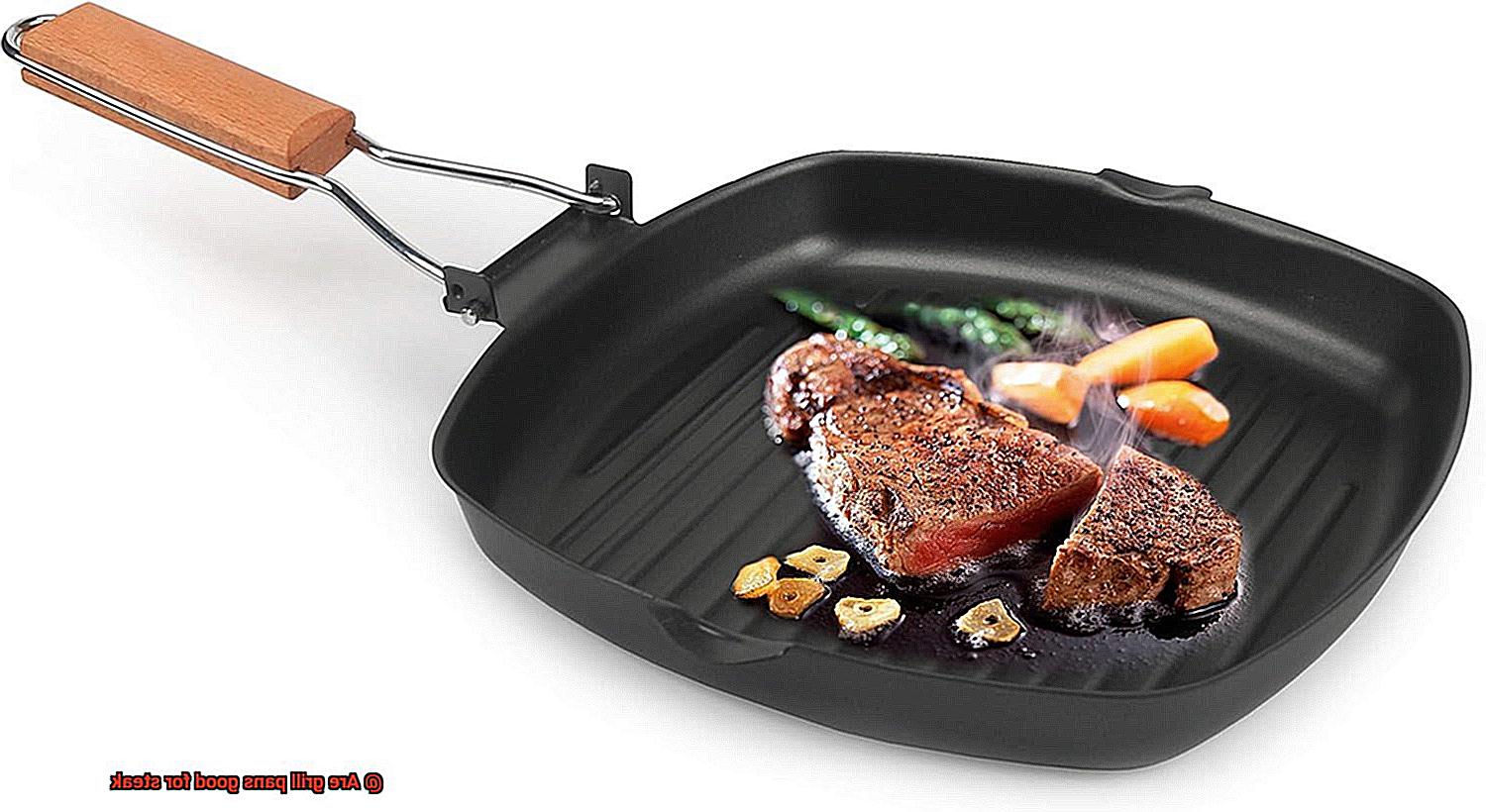
One of the most significant benefits of using a grill pan for steak is that it helps keep all those delicious juices and flavors intact. Unlike traditional frying pans where juices tend to pool around the meat, grill pans let them drip off into the grooves of the pan, resulting in a more flavorful and juicy steak.
And let’s not forget about cleaning – nobody has time for scrubbing burnt-on food from their cookware. Fortunately, grill pans are easy to maintain and made with durable materials such as cast iron or stainless steel. The ridged design also makes it easier to remove food particles and prevent sticking.
Choosing the Right Type of Grill Pan
It’s time to elevate your cooking game by investing in a grill pan. However, with so many options available, it can be overwhelming to choose the right one. As an expert, let me guide you through the factors to consider when selecting the perfect grill pan for cooking steak.
Firstly, let’s discuss the materials used in making grill pans. Cast iron grill pans are a top choice for steak lovers as they retain heat and distribute it evenly, creating those coveted sear marks and charred flavor. Non-stick grill pans are another choice that requires less oil or butter and is easy to clean. However, they may not give the same smoky flavor as cast iron. Stainless steel grill pans are also available but tend to be pricier and may not retain heat as well.
Size matters. Consider how many steaks you plan to cook at once. A larger grill pan allows you to cook multiple steaks, while a smaller one may be more suitable for single servings. Don’t forget, a crowded pan can lead to uneven cooking.
Finally, let’s talk about the handle. A sturdy handle that remains cool to the touch during cooking is essential. You don’t want to risk burns or dropping your steak mid-flip.
Factors to Consider When Cooking Steak on a Grill Pan
If so, there are several factors you need to consider to achieve that mouth-watering, restaurant-quality taste.
Firstly, the type of grill pan you use is essential. Cast iron is the most popular choice as it evenly distributes heat and retains it well. However, stainless steel and aluminum can also be used but require more attention to prevent sticking or uneven cooking.
Thick or thin? The thickness of your steak matters. Thick cuts will require longer cooking times and might need finishing in the oven to ensure even cooking. On the other hand, thinner steaks can be cooked entirely on the grill pan for a quick and easy meal.
Temperature is also crucial in achieving that perfect sear on your steak. Preheat your grill pan over medium-high heat for several minutes before adding the steak. This ensures that the steak sears properly and develops a crust on the outside while remaining juicy and tender on the inside.
Seasoning is an essential factor too. Salt and pepper are a must, but don’t be afraid to get creative with other herbs and spices like garlic, rosemary, or paprika for added flavor. Be sure to season both sides of the steak before cooking for maximum taste.
Lastly, allowing your steak some time to rest after cooking is vital in ensuring it remains juicy and tender. Resting for at least 5-10 minutes before slicing into the steak will allow its juices to redistribute throughout the meat.
How to Achieve the Perfect Sear on Your Steak
And while an outdoor grill may be the traditional method, a grill pan can be just as effective if you follow these simple steps.
Choose the Right Grill Pan
The first step in achieving a perfect sear on your steak is using the right type of grill pan. Look for a heavy, cast iron or stainless steel pan with deep ridges. These ridges not only add those coveted grill marks, but also allow excess fat to drip away creating a healthier finished product.
Preheat Your Grill Pan
A hot grill pan is essential for achieving that crispy crust on your steak. Preheat your pan over medium-high heat for at least five minutes before adding your steak. You should hear a sizzle when the steak hits the pan. If you don’t, it’s not hot enough.
Season Your Steak
To enhance the flavor of your steak, season it generously with salt and pepper or any other seasonings of your choice. This will also help create a delicious crust when seared.
Cook Your Steak
Add a small amount of oil to the pan and let it heat up before adding the steak. Once you’ve added your steak to the grill pan, resist the urge to move it around. Allow it to cook undisturbed for 2-3 minutes on each side, depending on the thickness of the steak and how well done you prefer it.
Let Your Steak Rest
After cooking, let your steak rest for a few minutes before slicing into it. This allows the juices to redistribute throughout the meat, resulting in a more flavorful and tender final product.
Tips for Cooking Thicker Cuts of Steak
Thicker cuts of steak can be intimidating to cook, but with a grill pan and the right techniques, you can easily achieve a delicious and perfectly cooked steak. Here are some tips for cooking thicker cuts of steak on a grill pan:
Preheat Your Grill Pan
The key to evenly cooked steak is to preheat your grill pan properly. Heat the pan over medium-high heat for several minutes until it’s hot enough that a drop of water sizzles and evaporates on contact. This ensures that your steak will cook evenly and develop a nice sear.
Season Generously
Thicker cuts of steak benefit from being seasoned generously with salt and pepper at least an hour before cooking. This allows the flavors to penetrate the meat and adds depth to the final dish. You can also rub the steak with olive oil or another high-heat oil to help prevent sticking.
Use High Heat
To get that perfect sear on your steak, use high heat when cooking on a grill pan. This helps lock in the juices and flavor, resulting in a tender and juicy steak. Don’t be afraid of high heat, as it’s necessary for creating that nice crust on your steak.
Avoid Moving Your Steak Too Much
Once you’ve added your steak to the grill pan, let it cook for several minutes on one side before flipping it over. Moving your steak too much prevents it from developing that nice crust, so be patient and let it cook undisturbed for a few minutes. You’ll know it’s ready to flip when it easily releases from the pan.
Use a Meat Thermometer
When cooking thicker cuts of steak, using a meat thermometer is essential to ensure that it reaches the desired level of doneness. For medium-rare, aim for an internal temperature of 130-135°F. For medium, aim for 135-145°F.
Let Your Steak Rest
Once your steak is cooked to perfection, let it rest for several minutes before slicing into it. This allows the juices to redistribute throughout the meat, resulting in a more tender and flavorful steak. Don’t skip this step, as it’s crucial to achieving the perfect steak.
Letting Your Steak Rest After Cooking
It may seem like an unnecessary step, but trust us, it makes all the difference.
When you remove your steak from the grill pan, it may look perfectly cooked on the outside, but the heat is still cooking the inside of the steak. If you were to cut into it right away, all those mouth-watering juices would spill out onto your plate, leaving you with a dry and tough piece of meat. That’s where letting your steak rest comes in.
Letting your steak rest allows the juices inside to redistribute and settle. This is especially important when cooking a thick cut of steak. By letting it rest for 5-10 minutes, those juices have time to settle and redistribute throughout the steak, resulting in a juicier and more flavorful piece of meat.
So how do you properly let your steak rest? It’s simple. Just remove it from the grill pan and place it on a cutting board or plate. Cover it loosely with aluminum foil to keep it warm and let it rest for 5-10 minutes. Use this time to prepare any side dishes or sauces that you plan on serving with your steak.
Once the resting time is up, remove the foil and slice your steak against the grain for maximum tenderness and flavor. The result? A perfectly cooked and juicy steak that will leave your taste buds dancing with delight.
In summary, letting your steak rest after cooking is not an optional step – it’s a crucial one. To savor every delicious bite of your hard work, don’t rush this process. Instead, give your steak the time it deserves to rest and settle before serving. Trust us, your taste buds will thank you.
Remember these key takeaways about letting your steak rest:
Pros and Cons of Using a Grill Pan for Steak
Using a grill pan for your steak may be just what you need. However, like any cooking method, there are pros and cons to consider before you start.
Let’s start with the pros. The most significant advantage of using a grill pan is the ability to achieve that mouth-watering grilled flavor we all crave without stepping outside. The ridges on the surface allow for even cooking and searing on both sides of the steak. Additionally, using a grill pan gives you more control over the cooking process. You can adjust the temperature and cooking time to achieve your desired level of doneness with precision. And lastly, using a grill pan is incredibly convenient, allowing you to cook steak indoors, regardless of the weather conditions outside.
On the other hand, there are some potential downsides. One factor to consider is smoke. Grilling on a pan can produce smoke, which can be unpleasant and even trigger smoke alarms in your home. Also, when using a grill pan, there is a risk of splattering from the fat and juices of the steak, making clean-up more challenging. Lastly, depending on your grill pan size, you may only be able to cook one or two steaks at a time, which can be inconvenient if you’re cooking for a larger group.
EW_HOyWAhWw” >
Conclusion
To sum up, a grill pan is an exceptional cooking tool for steak lovers when used correctly. The raised ridges on the surface of the grill pan allow for even cooking and charring on both sides of the steak, creating that irresistible smoky flavor and crusty texture. Grill pans are versatile and can be used on all stovetops, providing more control over the cooking process than traditional outdoor grills. They also retain excess fat, resulting in a healthier finished product.
When selecting a grill pan, it’s essential to consider factors such as material, size, and handle design. Preheating the grill pan over medium-high heat for at least five minutes before adding your steak is crucial to achieving that perfect sear. Additionally, seasoning your steak with salt and pepper or other herbs and spices enhances its flavor.
Thick cuts of steak require longer cooking times and may need finishing off in the oven to ensure even cooking. Using a meat thermometer is crucial to achieving your desired level of doneness. Allowing your steak to rest after cooking will allow juices to redistribute throughout the meat, resulting in a more tender and flavorful finished product.
While using a grill pan may have some potential downsides such as smoke production and splattering from fat and juices, these can be mitigated with proper technique and care. Ultimately, using a grill pan for cooking steaks provides convenience, versatility, and control over the cooking process resulting in delicious restaurant-quality steaks cooked right at home.

